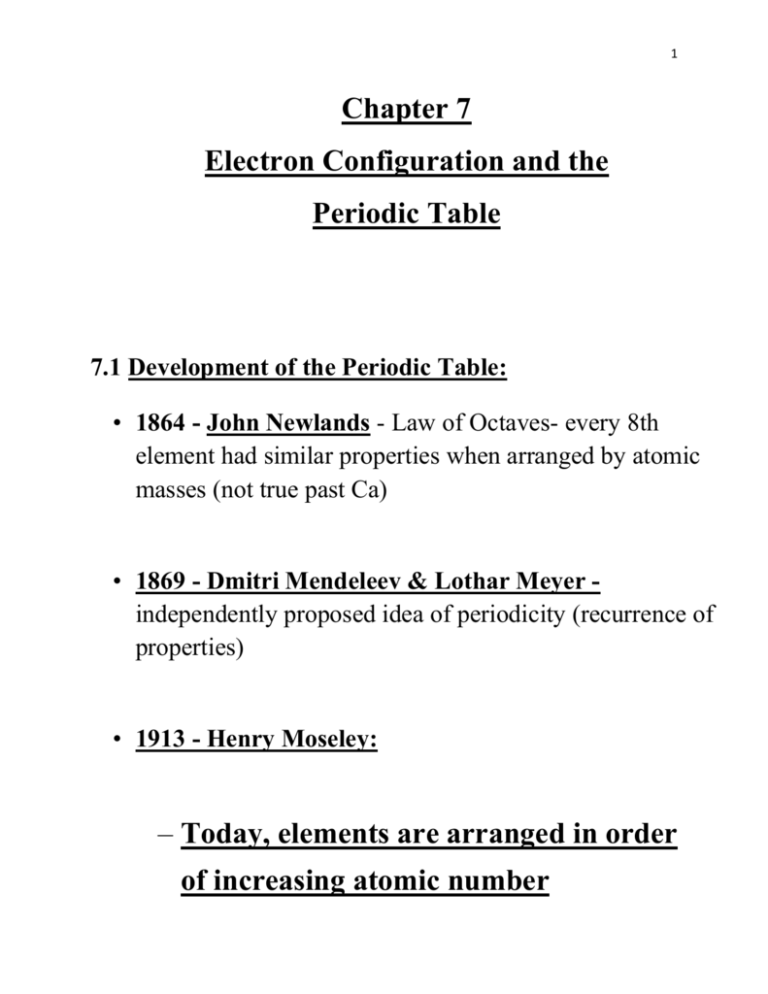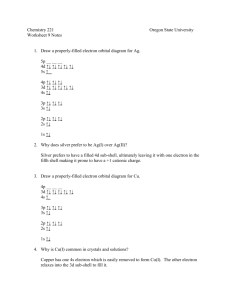radius properties
advertisement

1 Chapter 7 Electron Configuration and the Periodic Table 7.1 Development of the Periodic Table: • 1864 - John Newlands - Law of Octaves- every 8th element had similar properties when arranged by atomic masses (not true past Ca) • 1869 - Dmitri Mendeleev & Lothar Meyer independently proposed idea of periodicity (recurrence of properties) • 1913 - Henry Moseley: – Today, elements are arranged in order of increasing atomic number 2 Essential Elements in the Human Body The Modern Periodic Table 3 7.2 The Modern Periodic Table • Classification of Elements – Main group elements - “representative elements” Group 1A-7A – Noble gases - Group 8A all have ns2np6 configuration(exception-He) – Transition elements - 1B, 3B - 8B “d-block” – Lanthanides/actinides - “f-block” 4 • Predicting properties: • Valence electrons are the outermost electrons and are involved in bonding • Similarity of valence electron configurations help predict chemical properties • Group 1A, 2A and 8A all have similar properties to other members of their respective group • Groups 3A - 7A show considerable variation among properties from metallic to nonmetallic • Transition metals do not always exhibit regular patterns in their electron configurations but have some similarities as a whole such as colored compounds and multiple oxidation states. 5 • Representing Free Elements in Chemical Equations: • Metals are always represented by their empirical formulas (same as symbol for element) • Nonmetals may be written as empirical formula (C) or as polyatomic molecules (H2, N2, O2, F2, Cl2, Br2, I2, and P4). • Sulfur usually S instead of S8 – Noble Gases all exist as isolated atoms, so use symbols (Xe, He, etc.) – Metalloids are represented with empirical formulas (B, Si, Ge, etc.) 6 7.3 Effective Nuclear Charge: • Z (nuclear charge) = the number of protons in the nucleus of an atom • Zeff (effective nuclear charge) = the magnitude of positive charge “experienced” by an electron in the atom • Zeff increases from left to right across a period; changes very little down a column • Shielding occurs when an electron (valence) in a manyelectron atom is partially shielded from the positive charge of the nucleus by other electrons (core or inner) in the atom. • Core electrons (inner electrons) are constant across a period. • Zeff = Z - • is shielding constant (greater than 0 but less than Z) 7 Example: Li Be B C N Z 3 4 5 6 7 Zeff 1.28 1.91 2.42 3.14 3.83 8 7.4 Periodic Trends in Properties of Elements: • Atomic radius: distance between nucleus of an atom and its valence shell • Metallic radius: half the distance between nuclei of two adjacent, identical metal atoms • Covalent radius: half the distance between adjacent, identical nuclei in a molecule 9 Atomic Radii (pm) of the Elements 10 • Ionization energy (IE): minimum energy needed to remove an electron from an atom in the gas phase Na(g) Na+(g) + e – IE for this 1st ionization = 495.8 kJ/mol • In general, ionization energy increases as Zeff increases – Exceptions occur due to the stability of specific electron configurations 11 IE1 (kJ/mol) Values for Main Group Elements 12 Exception: in period 2 and 3 2 3 2A 3A 4A 5A 6A 7A Be B C N O F 899 800 1086 1402 1314 1681 Mg Al Si P 735 580 780 1060 1005 1255 S Cl Example: P : [Ne]3s23p3 S: [Ne]3s23p4 The electron–electron repulsion between paired electrons in 3p4 orbital in S makes it more easily to remove one of the electrons. 13 • Multiple Ionizations: it takes more energy to remove the 2nd, 3rd, 4th, etc. electron and much more energy to remove core electrons • Why? – Core electrons are closer to nucleus and experience greater Zeff e.g: Al : [Ne]3s23p1 Al(g) Al+(g) + e- I1 = 580 kJ/mol Al+(g) Al2+ + e- I2 = 1815 kJ/mol Al2+(g) Al3+ + e- I3 = 2740 kJ/mol Note: A jump would occur at I4 14 Given the following 1st, 2nd, and 3rd ionization energies for an element: I1 = 735 kJ/mol I2 = 1445 kJ/mol I3 = 7730 kJ/mol the element can be A) Mg [Ne]3s2 (jump would occur at I3, B) Na [Ne]3s1 (jump would occur at I2) C) Al [Ne]3s23p1 (jump would occur at I4) D) Si [Ne]3s23p2 (jump would occur at I5) E) P [Ne]3s23p3 (jump would occur at I6) Mg is ok) 15 Electron Affinity (EA): It is the energy change when an electron is added to an atom. Cl(g) + e- Cl-(g) H = -349 kJ/mol (exothermic process) Like ionization energy, electron affinity increases from left to right. Note: - Effective nuclear charge Zeff has greater effect on EA than the pairing of electrons. - The Addition of an electron to empty orbital is easier than the one to an orbital with unpaired electron. 16 • Metallic Character: – Metals: • Shiny, lustrous, malleable • Good conductors • Low IE (form cations) • Form ionic compounds with chlorine • Form basic, ionic compounds with oxygen • Metallic character increases top to bottom in group and decreases left to right across a period – Nonmetals: • Vary in color, not shiny • Brittle • Poor conductors • Form acidic, molecular compounds with oxygen • High EA (form anions) 17 – Metalloids: • Properties between the metals and nonmetals 18 7.5 Electron Configuration of Ions: • Follow Pauli exclusion principle and Hund’s rule as for atoms • Writing electron configurations helps explain charges memorized earlier • Ions of main group elements: – Noble gases (8A) almost completely unreactive due to electron configuration • ns2np6 (except He 1s2) – Main group elements tend to gain or lose electrons to become isoelectronic (same configuration as nearest noble gas) valence electron 19 Na: 1s22s22p63s1 Na+ 1s22s22p6 Na: [Ne]3s1 Na+ [Ne] (Na+ 10 electrons - isoelectronic with Ne) Cl: 1s22s22p63s23p5 Cl 1s22s22p63s23p6 Cl: [Ne]3s23p5 Cl [Ar] (Cl 18 electrons - isoelectronic with Ar) • Ions of d-Block Elements: – Recall that the 4s orbital fills before the 3d orbital in the first row of transition metals – Electrons are always lost from the highest “n” value (then from d) Fe: [Ar]4s23d6 Fe2+: [Ar]3d6 Fe: [Ar]4s23d6 Fe3+: [Ar]3d5 20 7.6 Ionic Radius: • When an atom gains or loses electrons, the radius changes • Cations are always smaller than their parent atoms (often losing an energy level) • Anions are always larger than their parent atoms (increased e repulsions) 21 • Isoelectronic Series: – Two or more species having the same electron configuration but different nuclear charges – Size varies significantly: 22 7.7 Periodic Trends in Chemical Properties of Main Group Elements: (Reading assignment)








